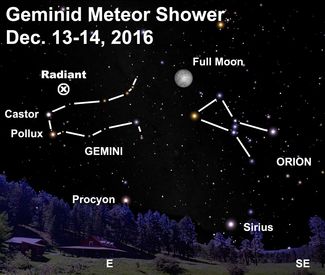Viewing the Moonlit Geminid Meteors
Last updated 12/8/2016 at 2:31pm
It's December, and with it comes colder temperatures throughout much of the Northern Hemisphere and the most prolific meteor shower of the year: the Geminid.
Never heard of it? Well, that's not a huge surprise. If you ask beginning stargazers which is the most spectacular meteor shower of the year, I'll bet many will cite the Perseid shower in mid-August. But most would be surprised to learn that the Geminid meteors are often brighter and more plentiful than the Perseids.
For this year's shower -- like many other things in life -- there's both good news and bad news.
First, the bad news. The 2016 Geminids peak during the evening of Tuesday, Dec. 13, and the pre-dawn hours of Wednesday, Dec. 14. Many people will not be able to get away mid-week to spend a night under the stars.
The second bit of bad news is that on the night of Dec. 13 we also have a full moon. Can't get much brighter than that! The full moon is a big showoff, and its light blots out many of the fainter meteors one can see.
The good news is that the Geminids often produce brilliant fireballs that can easily outshine the moonlight.
So how many can we expect to see under these conditions? Well, during a typical (moonless) Geminid shower, there can be as many as 100 or 120 per hour, so it would be significantly less than this. But if there were fireballs like those I've mentioned, you wouldn't remember much else anyway!
If the Geminids are so bright and prolific, why is it that people don't cite them as their favorite? My guess is because they occur during the wintertime when folks are generally unwilling to brave the cold to watch lights falling from the sky. Too bad, because I've always felt that the Geminids can easily be the best shower of the year, even under moonlight.
Geminid meteors all seem to radiate from a point in the constellation Gemini, the twins, which appears low in the east-northeastern sky during early evening hours in mid-December. This means that sky watchers who can't stay up all night can at least catch some meteor activity before retiring.
Around the midnight hour, Gemini lies nearly straight overhead and showers the sky with meteors that fall in all directions. And if you to trace their paths backward, those associated with the shower seem to radiate from a point (called the "radiant") just west of the bright star Castor.
My recommendations for watching the Geminid meteor shower are simple. First, be sure to dress warmly and have a thermos of hot chocolate on hand, for example, to make the night even more enjoyable. Next, head away from the city lights to where the only distraction is the moonlight. And finally, lie back on a sleeping bag or lawn chair and scan the entire sky with your eyes.
I promise that if you can get away and catch some great Geminid fireballs, you'll definitely want to put this on your observing list for 2017, when moonlight will be no issue at all.




